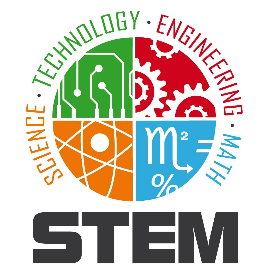STEM (EN)
| STEM |
What is about?
By definition: broad set of disciplines embracing Science, Technology, Engineering, and Math
Practical implementation: a number of project, each project conducted by several students
How did we choose the projects ?
- Regional, national or EU level competitions for schools.
- Building on expertise and “traditions” of our school (e.g. CanSat, STEM Olympiad ,Moon camp,.. )
- Preferring activities naturally more exciting for pupils (e.g. robots, visual programming, space-related projects)
STEM : implementation at EEBIII
- It is an optional activity that students can voluntarily follow in periods without classes (P6-7)
- Managed by coordinator with some experience from previous years:
- Rayja Inapakutikala (Mathematics, ICT teacher)
Kickoff of STEM activities
- Advertising to a wide audience, including S1-S7 pupils along with their parents
- Presentation of a selection of projects
- During few weeks, students have clustered on specific projects following their tastes, passions and knowledge
- All communications and supporting materials have been posted on a specific Teams channel, with subchannels for each project.
A “students-driven” activity
In competitions among projects, no pre-determined idea has been imposed by coordinators: Students themselves are supposed to be the main creators
- Engagement in competitions typically follows the path:
- Coordinators inform about guidelines and rules for the competitions
- Students are free to develop their own idea
- Coordinators give suggestions about the idea feasibility, provide expertise, indicate appropriate supporting material and monitor deadlines
Students have full liability of:
- Practical implementation of an idea
- Contacting experts, purchasing material, sending reports
- Sharing roles among team members, coordinate the team, meet deadlines ➢ Students are the final responsible of the failure or the success of a project.
STEM projects
Moon Camp(S1,S2 and S3):
Optimize a 3D-design for equipment of a futuristic Moon camp (Lunar Lander, Lunar Orbital Space Station, Lunar Rover, Moon Base, Rocket, Space Suit ) using a professional program. Each team’s mission is to 3D design only one component of a Moon Camp, using Tinkercad.
Teams can choose to design the:
- Lunar Lander
- Lunar Orbital Space Station
- Lunar Rover
- Moon Base
- Rocket
- Space Suit
Coding and robots(S1,S2,S3)
Introduction to coding logic (based on text or on blocks), using visual tools. Application to robotic vehicles and arms performing user-defined operations.
Micro bit(S3, S4,S5)
The micro:bit is such a tangible way to develop coding. It’s real, it’s exciting and it gives students confidence to try new things and experiment.
You tell computers like the micro:bit what to do by giving them instructions. Sets of instructions for computers are called programs.
Programs are written in code, a language that both you and the computer can understand.
You can program your micro:bit in the online MakeCode block or Python text editors.
Our Let’s code page helps you choose the one that’s right for you.
Arduino(S4,S5)
Arduino Uno can detect the surroundings from the input. Here the input is a variety of sensors and these can affect its surroundings through controlling motors, lights, other actuators, etc. The Arduino Uno is an open-source microcontroller board based on the Microchip ATmega328P microcontroller and developed by Arduino.cc. The board is equipped with sets of digital and analog input/output (I/O) pins that may be interfaced to various expansion boards (shields) and other circuits. Students will learn how to code and connect the circuit to the requirement.
CANSAT(S6,S7)
A CANSAT is a device incorporated in the volume and shape of a 33cl can. The challenge for students is to integrate the main subsystems of the experiment within a restricted volume. The CANSAT is then launched at an altitude of 1000 meters thanks to a rocket and his mission begins: to carry out a scientific experiment and land safely.
Students will be responsible for all aspects of the scientific project:
- They define the purpose of their mission
- They design the CanSat and build the components
- They take care of the tests and the preparation for the launch
- They then analyse the collected data
| EUROPEAN SCHOOLS SCIENCE SYMPOSIUM (ESSS) |
What is about?
The European Schools Science Symposium is a competition open to students of the European Schools years 1 to 7 inclusive. Individuals or groups of up to 3 students, guided by a teacher-mentor, are encouraged to explore an area of scientific interest of their choice, not normally covered by the European Schools’ science syllabus.
The projects will be showcased during the symposium and judged by teachers and subject experts. Prizes will be awarded for the best entries. Juniors and seniors will be judged separately.
The overall winning project in the senior category will represent the European Schools at the European Union Contest for Young Scientists later in the year. The school hosting the 2024 ESSS is the Europäische Schule RheinMain
How did we choose the projects?
Criteria for entry
The projects should demonstrate that the student(s) has/have undertaken some significant original work.
Examples include an experiment based practical investigation made by the students, original design of an item or process, and survey-based investigations involving the first-hand collection and processing of meaningful statistics.
Projects that are not suitable include those reproducing text-book science experiments, or those exclusively quoting second-hand data or information from books and the internet. If, from the information given on the Abstract, the working party deem the proposal to be unsuitable for the competition, they reserve the right to decline the entry.
Regulations
- Each competitor may only submit one entry to the ESSS, either as an individual or as part of a team.
- If school resources have been used to develop a project, the project has to be submitted to the ESSS before it goes to another competition.
- The language of entry must be one of the working languages of the European Schools.
- Projects which have previously been entered into the ESSS, or a national or international competition such as EUCYS, are not eligible for resubmission. However, a follow-up project of a previously submitted project can be submitted.
- Participation in the ESSS does not exclude participation in subsequent competitions.
- The overall winning project in the senior category will represent the European Schools at the European Union Contest for Young Scientists (EUCYS) later in the year.
- Students can only enter a project as exclusively theirs if it is carried out without any contribution from other students.
- Projects must be genuinely extra-curricular, in that they have not formed part of the compulsory components of any European School course, nor been used to establish a student’s A or B mark.
- There must be evidence, to the satisfaction of the selection committee, that the project is the original and individual work of the student(s), and that only reasonable levels of guidance have been given.
- Entry forms must be completed with all relevant information. Incomplete entry forms will not be accepted. It is the responsibility of the entrant to inform the ESSS of any change of contact details.
- The judges’ decisions are final, and no appeals will be heard or correspondence entered into.
- A full list of prize winners will be published on the ESSS website and in any other publications selected by the organisers.
- By entering the competition, entrants agree that any document submitted to the organisers of the competition can appear on public display and be used on the internet and in printed form to promote the competition.
- During the event, students are bound by the rules of the host school. The organisers reserve the right to send home at his or her parent’s expense any student breaking these rules.
- By entering, entrants will be deemed to have agreed to be bound by these rules.
- The ESSS reserves the right to revise these rules at any time. Any changes will be communicated.
The judging process
The judges come from a range of scientific backgrounds, working in both academia and industry, and will be looking for evidence of genuine scientific achievement, taking into account the ages of the entrants.
The assessment criteria and the different steps of the competition are described in Annexe 5 of the ESSS Handbook.
ESSS: implementation at EEBIII
- It is an optional activity that students can voluntarily apply for entry at the start of the school year.
- Managed by a team of science teachers who act as mentors to the student projects
Kick-off of ESSS activities
- Advertising to pupils along with their parents, by email, and on school monitors at start of year, looking for submissions of ideas.
- Presentation of a selection of projects, abstract, report, poster & power-point to groups of science classes.
- All communications and supporting materials have been posted on a specific Teams channel, with subchannels for each project.
A “students-driven” activity
In competitions among projects, no pre-determined idea has been imposed by coordinators: Students themselves are supposed to be the main creators.
Engagement in competitions typically follows the path:
- Coordinators inform about guidelines and rules for the competitions
- Students are free to develop their own idea
- Coordinators give suggestions about the idea feasibility, provide expertise, indicate appropriate supporting material and monitor deadlines
- Students have full liability of:
- Practical implementation of an idea
- Contacting experts, purchasing material, sending reports
- Sharing roles among team members, coordinate the team, meeting deadlines
- Students are the final responsible of the failure or the success of a project.
EU Schools Science Symposium information can be found here: http://esss.wp.eursc.eu/
European Contest for Young Scientists Information can be found here: http://esss.wp.eursc.eu/eucys/
This event was in Brussels this year, and several of our students went independently on Wednesday afternoon to see the projects.
It is in a different European city each year.


